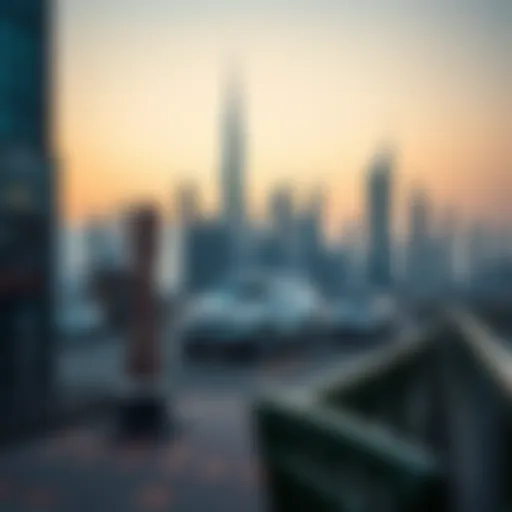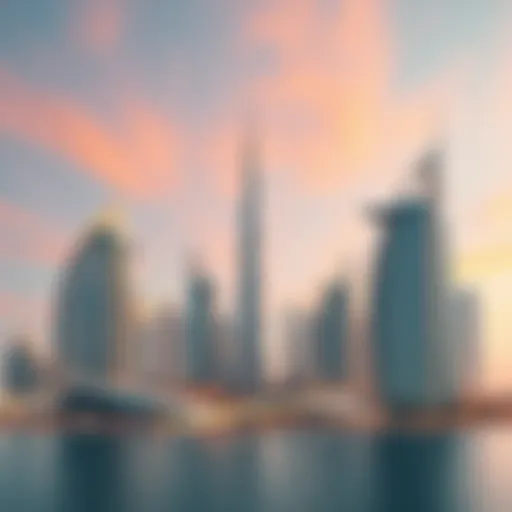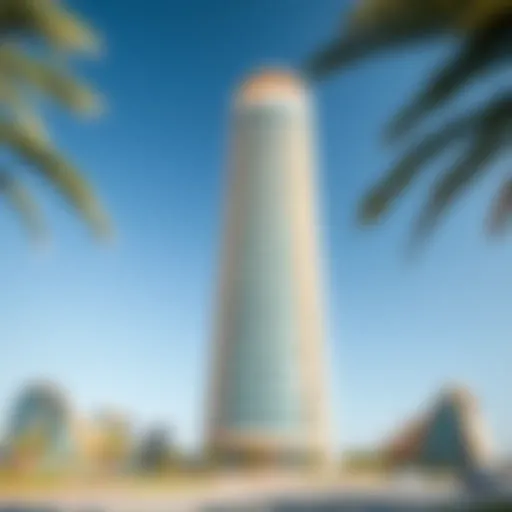Exploring the Golden Souk of Dubai: A Jewel in the Heart of the City
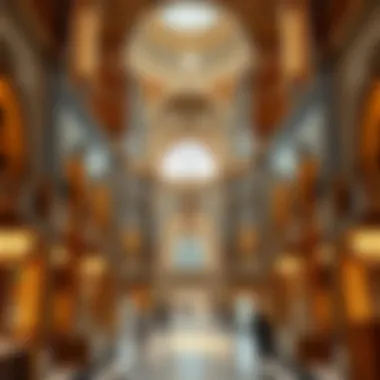

Intro
Nestled within the bustling heart of Dubai lies a marketplace that sparkles with a golden luster, embodying the essence of the city’s rich cultural tapestry. The Golden Souk, a sprawling network of shops brimming with exquisite jewelry and traditional craftsmanship, serves as a pivotal point for both locals and tourists. When one wanders through its narrow lanes, it’s hard not to feel the pulse of a vibrant economy, reflected in the constant ebb and flow of shoppers eager to experience its allure.
The Golden Souk is much more than a mere shopping destination; it represents a fusion of history, tradition, and modernity. As one traces its roots back to the early days of Dubai, it becomes clear that this dazzling bazaar has played an instrumental role in shaping the socio-economic landscape of the region.
In this article, we will peel back the layers of the souk, exploring various facets such as:
- Historical Significance: The transformation of Dubai over the years, and how the souk fits into that narrative.
- Architectural Features: A closer look at the design and layout that make the souk a unique gem in the city.
- Economic Impact: Insights into how the souk influences local commerce and tourism.
- Cultural Role: The place of the souk in the everyday lives of residents and its importance in maintaining cultural heritage.
By digging deeper into these aspects, we will provide valuable insights for investors, homebuyers, and others keen to understand the broader implications of this iconic marketplace in Dubai's real estate sector. This journey through the Golden Souk is poised to be a comprehensive guide, helping you appreciate not just its beauty, but its significance in the fabric of Dubai.
Prolusion to the Golden Souk
The Golden Souk, nestled in the vibrant heart of Dubai, is more than a mere marketplace. It embodies a rich tapestry of culture, history, and economic dynamics that showcase the transformation of the city over the decades. This iconic landmark holds not just precious metals and gems; it represents the aspirations and sentiments of countless people who visit, whether they are tourists or locals.
As you step into the souk, the first thing that strikes your senses is the splendor of gold gleaming under the warm Arabian sun. Jewelry stores line the narrow alleys, displaying intricate designs that tell stories of both traditional craftsmanship and modern influences. This sector has become a significant player in Dubai’s economy, attracting investors and shoppers alike, making the Golden Souk a vital component of the local landscape.
Importance of the Golden Souk
Understanding the significance of the Golden Souk goes beyond surface-level observation. Here are some key considerations:
- Cultural Heritage: The souk is steeped in tradition, serving as a living archive of Dubai's history. It’s a place where generations of families have passed down their jewelry-making skills, showcasing artistry that is both unique and locally inspired.
- Economic Role: This marketplace is crucial to Dubai’s economy, often called the City of Gold for its vibrant trade in precious metals. It is a focal point for local businesses and attracts significant foreign investment, which is essential for growth.
- Tourism Magnet: Tourists flock here for the experience of bargaining and exploring. The bustling atmosphere, combined with the chance to buy high-quality gold and jewels, makes it a must-visit destination.
Indeed, the Golden Souk is a reflection of Dubai's rapid transformation from a small trading post into a global hub, illustrating how commerce and culture can intertwine beautifully.
In summary, the Golden Souk is not just a shopping destination but also a key player in understanding Dubai's identity. Its significance extends into economic, cultural, and social realms, making it an essential focal point for anyone keen on grasping the nuances of this remarkable city.
Historical Context
Understanding the historical backdrop of the Golden Souk is crucial in appreciating its present stature within Dubai and beyond. From its humble beginnings to becoming an emblem of the city’s cultural and economic milieu, the souk's history chronicles the story of Dubai itself. The significance lies not only in its architectural marvels and vibrant market stalls, but also in how this marketplace reflects the evolution of trade, craftsmanship, and community spirit over the decades.
Origins of the Golden Souk
The origins of the Golden Souk can be traced back to the mid-20th century when Dubai was little more than a fishing village known for its pearling industry. The trade routes that formed during this time were pivotal in establishing the city as a commercial hub. Merchants from various backgrounds converged, bringing with them diverse goods and cultural influences. Initially, the souk was a modest convenience for locals, where gold and silver were traded in small amounts. As the oil boom transformed Dubai's economy, the souk began to flourish, attracting not only local customers but also international tourists drawn by the allure of precious metals and gemstones.
In these early days, the souk was largely unregulated, characterized by informal trading practices. The makeshift stalls were often manned by traders from India and the Middle East, each adding their unique flair to the marketplace. This patchwork of cultural influences can be seen today in the designs and styles of jewelry, showcasing a blend of traditional and contemporary craftsmanship.
Evolution Through the Decades
As Dubai transitioned from a small coastal town to a global cosmopolitan city, the Golden Souk evolved in tandem. The late 20th century marked significant developments: new regulations were introduced, professionalizing the trade and establishing a framework for quality assurance within the industry. This fostered a sense of trust among both buyers and sellers.
In the 1990s, with the rise of tourism, the souk underwent a transformation. Its layout expanded, featuring not just gold, but also precious stones and intricate artifacts. This period saw the emergence of specialization within the souk, where shops began to focus on unique selling propositions, such as bespoke jewelry designs or ethnic ornaments. The atmosphere became more festive, with significant events and exhibitions attracting both domestic and international crowds.
Today, the Golden Souk stands as a confluence of tradition and innovation. While the artistry and craftsmanship maintain their age-old heritage, the integration of modern marketing techniques and digital commerce reflects an adaptive nature that resonates with a diverse clientele. In this context, the evolution of the souk is a testament to Dubai's dynamic economy, mirroring its growth and aspiration to be at the forefront of global trade.
Architectural Insights
The Golden Souk is more than just a marketplace; it is a testament to Dubai’s architectural ingenuity and a reflection of its cultural roots. The importance of exploring the architectural insights of the souk lies in understanding the intricate blend of traditional and modern design elements that have evolved over time. From the moment visitors step into the souk, they are greeted with a magnificent display of craftsmanship that captivates and charms.
The design of the souk has several key features that not only enhance the aesthetic appeal but also ensure functionality. The careful layout and strategic placement of stalls invite exploration, making it easy for visitors to wander and discover hidden gems. The use of arches and high ceilings creates an open space that enhances the airflow, helping to keep the environment cool, even during the sweltering heat of summer.
Another notable aspect is the incorporation of light—a precious commodity that plays a significant role in showcasing the dazzling gold and jewelry on display. Natural sunlight floods through large windows and gaps, creating a warm ambiance that enhances the glimmer of the products on sale. This interplay between light and materials makes for a shopping experience that is both visually appealing and practical.

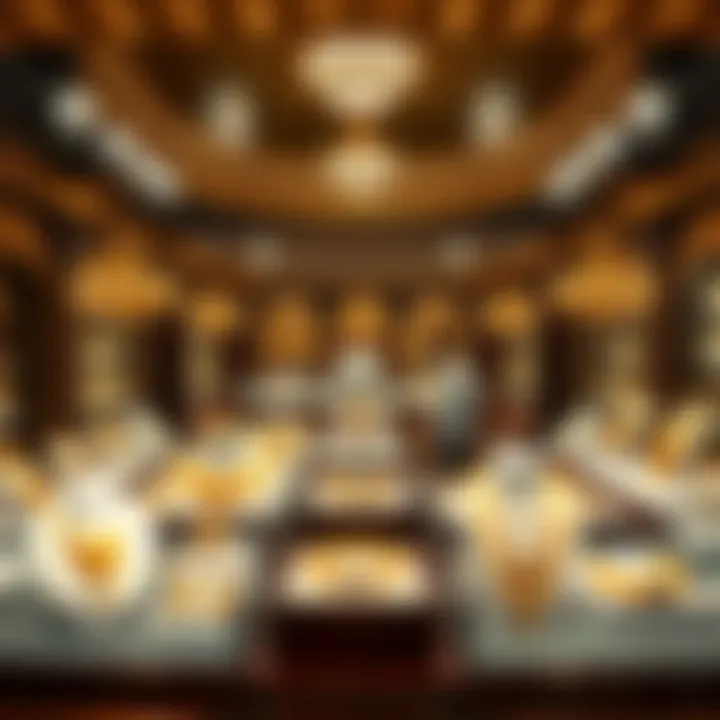
Design Features
The design features of the Golden Souk are not just elements of style; they are imbued with cultural significance.
- Open-air Concept: Unlike many modern shopping centers that confine shoppers, the souk promotes an open-air environment. This fosters a lively atmosphere where sounds and smells intertwine, making each visit unique.
- Traditional Elements: The use of traditional Islamic architectural motifs helps maintain a cultural continuity that speaks to the soul of the region. Intricate tile work and detailed wood carvings serve as reminders of a rich historical legacy.
- Functional Layout: Navigation within the souk is intuitive. The stalls are organized to facilitate an effortless flow of foot traffic, allowing for exploration without congestion.
Overall, these design features create an experience that is simultaneously exhilarating and serene, embodying the very essence of Dubai's vibrant market culture.
Materials and Craftsmanship
Craftsmanship at the Golden Souk is nothing short of exceptional. The materials utilized and the skill of the artisans contribute significantly to the overall allure of the souk.
- Local Materials: The use of locally sourced materials, such as stone and wood, not only supports local artisans but also reflects the natural resources of the region. These materials are often treated and finished with traditional techniques, preserving the craftsmanship that has been passed down through generations.
- Artisanal Techniques: Goldsmithing and jewelry-making are taken seriously in the souk. Many artisans employ methods that date back centuries, ensuring each piece is not merely a commodity but a work of art.
- Customization Options: A notable aspect of the craftsmanship in the Golden Souk is the ability for shoppers to commission custom jewelry. This practice allows clients to work directly with skilled artisans to create unique pieces that hold personal significance.
Craftsmanship in the Golden Souk is a celebration of tradition, skill, and artistry, converging to form a marketplace that is rich in culture and history.
In summary, the architectural insights of the Golden Souk reveal a marketplace that is inextricably connected to Dubai’s cultural identity. Through its design features and the exquisite craftsmanship on display, the souk evolves as a dynamic entity that continues to attract visitors from all corners of the globe, offering a glimpse into the city’s storied past while embracing its vibrant future.
The Shopping Experience
The shopping experience at the Golden Souk is not just about buying items; it’s a captivating journey through time, tradition, and craftsmanship. This bustling marketplace serves as a microcosm of Dubai itself—where the old meets the new in a spectacular fashion. Visitors and locals alike are drawn to the souk not only for its shimmering offerings but also for its rich cultural tapestry and vibrant atmosphere.
Shopping here is layered with various nuances. You get to engage with merchants who have an extensive knowledge of the products they sell, making the shopping experience profoundly educational. Each visit can be unique, dictated by the interactions you have, the stories you hear and the items you choose to purchase.
Types of Goods Offered
The Golden Souk is renowned for an impressive range of items. Here’s a closer look at the specifics of what can be found.
Gold Jewelry
Gold jewelry is the star of the show in the Golden Souk. The sheer variety is astonishing, from intricately designed necklaces to elegant bangles. The main allure of gold jewelry here lies in its quality and purity, often being 22K or 24K, which assures durability and value.
Whether it's for generations to come or just for a special occasion, gold jewelry holds sentimental value. Many see it as an investment, as its worth tends to rise over time. However, one must navigate the pricing carefully; while many items sparkle beautifully, knowing the karat and negotiating are crucial elements for becoming a savvy shopper.
- Unique Feature: Customization options are available, allowing buyers to personalize their pieces.
- Advantage: High purity and craftsmanship.
- Disadvantage: Initial cost can be substantial, and it's important to compare across stalls before purchase.
Precious Stones
Wherever you turn in the souk, you're oftentimes greeted by displays of precious stones like diamonds, emeralds, and sapphires, all twinkling under the market lights. The luminescence of these stones adds a touch of magic to the shopping experience.
Precious stones serve not just as accessories but also as investments. Their value often appreciates over time, making them a popular choice for both casual buyers and serious investors. Their distinctive hues and the stories behind each gem contribute to a unique allure, drawing in enthusiasts and collectors alike.
- Unique Feature: Many stones are sourced from all over the globe, offering variety.
- Advantage: Potential for considerable return on investment.
- Disadvantage: Authenticity verification is crucial and may require professional assistance or appraisal.
Traditional Artifacts
Beyond jewelry, the Golden Souk also showcases traditional artifacts, providing a glimpse into the rich heritage and culture of the region. From intricately designed ornate boxes to handcrafted textiles, these artifacts embody centuries of tradition.
Shopping for traditional artifacts offers a sense of connection to the past. Many visitors take home these items as mementos that can spark conversations or serve as decorative pieces that echo a deeper narrative. Artifacts not only hold aesthetic value but also represent craftsmanship that is deeply embedded in the region’s identity.
- Unique Feature: Each artifact often has a backstory or symbol that carries historical significance.
- Advantage: These pieces can serve as wonderful gifts or keepsakes.
- Disadvantage: Quality and craftsmanship can vary widely, requiring careful consideration while selecting.
Negotiations and Bargaining Culture
One of the quintessential elements of the shopping experience at the Golden Souk is the art of negotiation. It's not merely about plucking an item off a rack; it’s a dynamic dance between buyer and seller. This thriving barter culture allows shoppers to engage with merchants, securing the best possible price through conversation and a bit of persuasive charm.
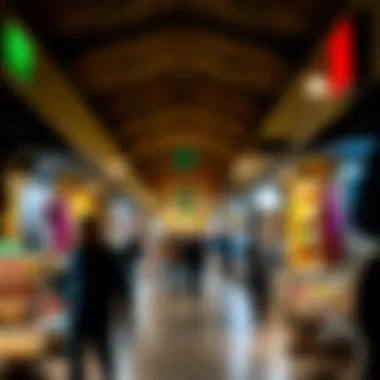
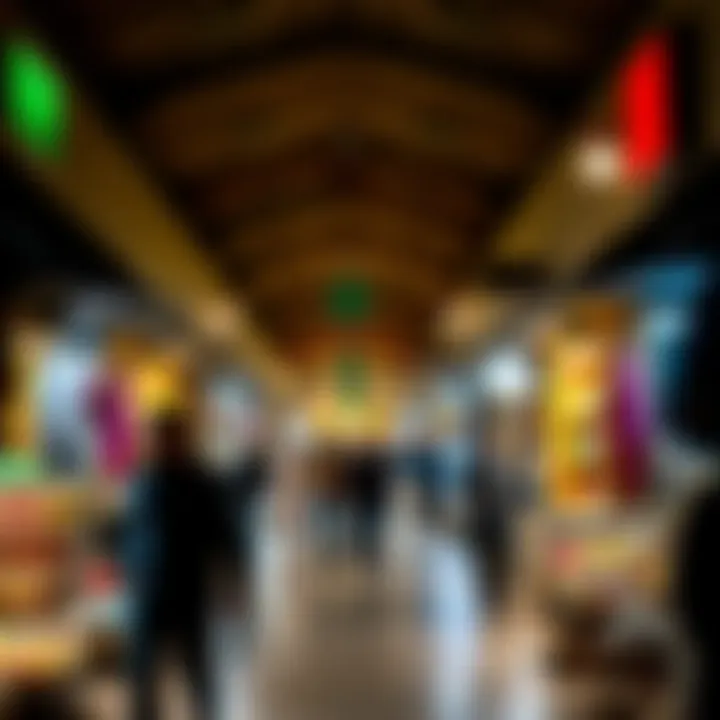
Merchants expect negotiations. They often start with prices that have room for discussion. This cultural aspect is not only necessary but part and parcel of the shopping rituals here. Knowledge of typical market prices can empower buyers, making it easier to spot a good deal.
While negotiating can feel intimidating for some, remember: it’s all in good fun. Successful negotiations often lead to a shared smile with the seller, creating a friendly atmosphere. This interaction makes the shopping experience more than a transaction—it becomes a story in itself.
"The shopping experience at the Golden Souk isn’t just about purchasing items; it’s about an unfolding narrative rich with history, culture, and meaningful interactions.”
Engaging with the souk transforms a simple shopping trip into a rich exploration of Dubai’s cultural fabric, leaving lasting impressions and cherished memories.
Economic Significance
The Golden Souk is more than just a marketplace; it stands as a cornerstone of Dubai's economic framework. This bustling hub not only captivates visitors with its dazzling displays of gold and precious stones but also holds profound implications for both the local economy and wider regional trade.
Role in Dubai's Economy
When it comes to understanding the value of the Golden Souk in Dubai's economy, it’s essential to realize that it acts like a finely-tuned engine, driving employment, trade, and tourism. The souk is a significant contributor to the retail sector, attracting both tourists and locals, proving itself a magnet for economic activity.
- Job Creation: It provides jobs to hundreds, if not thousands, of workers including sales staff, security personnel, and maintenance crews. This role in employment is vital in a city like Dubai, which thrives on diverse workforce participation.
- Tourism Revenue: Tourists flock to the souk, with many designating it a must-visit site on their lists. That brings in not only direct revenue through sales but also supports related businesses like restaurants, hotels, and taxi services. Indeed, visitors often walk away with not just jewelry, but also memories of an unforgettable experience, weaving the thread of tourism into the local economy.
- Cultural Exchange: It's a hub that fosters cultural exchange as well. Visitors from all over the globe come and bring with them different customs and styles, enriching the local market. This mingling serves to boost economic resilience, as the marketplace adapts to diverse tastes and preferences.
In sum, the Golden Souk is a dynamic player in Dubai's economy, intimately connected to the threads of retail, employment, and tourism.
Impact on Local Artisans
The charm of the Golden Souk is rooted not just in its opulent displays, but also in its support for local artisans and craftspersons. The souk's impact on these individuals is multifaceted:
- Preservation of Craftsmanship: With countless shops showcasing traditional artistry, the souk helps keep ancient goldsmithing and jewelry-making techniques alive. Local artisans find their labor respected and valued in a marketplace that celebrates craftsmanship.
- Economic Opportunities: The presence of the souk offers artisans a platform to sell their work and gain financial independence. Many small-scale craftsmen sell their pieces directly, enabling them to receive fair compensation for their skilled labor.
- Community of Creatives: The souk fosters a thriving community where artisans can share insights, collaborate on projects, and innovate. This comes not just with tangible goods but an exchange of ideas, further boosting creativity and quality in their work.
"Artisans at the Golden Souk aren't just sellers; they are the storytellers of culture, each piece of jewelry narrating tales that resonate with centuries of artistry."
Thus, the Golden Souk serves as both a beacon for local artisans, providing them with economic avenues as well as a nurturing ground for their heritage. The interplay between commerce and culture here contributes richly to the economic landscape of Dubai, benefiting not just the city but also the artisans who continue to shape its identity.
Cultural Importance
The Golden Souk is not just a marketplace; it is a living testament to Dubai’s cultural fabric. Its significance extends beyond the mere trade of gold and jewelry. The souk embodies deep-rooted traditions, offering both locals and visitors a glimpse into the age-old customs that have shaped the identity of the Emirate.
Symbol of Tradition
The Golden Souk serves as a symbol of tradition in Dubai. Here, age-old craftsmanship meets contemporary styles, creating a unique blend that honors both heritage and modernity. The artisans who work within these stalls are often descendants of generations who have worked with gold, carrying forward skills passed down through time. This connection to the past is palpable in every piece of jewelry, from intricate bangles to stunning necklaces.
Furthermore, gold is more than just a commodity; it embodies wealth and prosperity in Emirati culture. It holds deep meanings in various celebrations and traditional ceremonies, making it an essential part of the local customs. For many families, purchasing gold is a rite of passage, often linked to weddings and major life events. This practice solidifies the link between the souk and community values, showcasing how tradition lives and breathes through commerce.
Communal Gatherings and Festivals
The Golden Souk also plays a crucial role in communal gatherings and cultural festivals. Throughout the year, various events bring together the local community, fostering a spirit of unity and celebration. Events such as Eid al-Fitr and the Dubai Shopping Festival see the souk bustling with activity, with special promotions, performances, and displays.
During these festivals, the souk transforms into a hub of vibrant cultural expressions. Not only do visitors get to indulge in jewelry shopping, but they also experience traditional music, dance, and crafts that celebrate the rich heritage of the UAE.
For instance:
- Eid al-Fitr: After Ramadan, families gather to celebrate with gold gifts symbolizing blessings and new beginnings.
- DSF: The Dubai Shopping Festival showcases discounts and events, drawing in tourists and residents alike, making it a melting pot of cultures.
These festivals are crucial for nurturing a sense of belonging among citizens and promoting the souk as a cultural cornerstone.
"The Golden Souk is not merely a place to shop; it is a vital part of Dubai's identity, encapsulating the traditions and communal spirit of its people."
Tourism and Visitor Insights
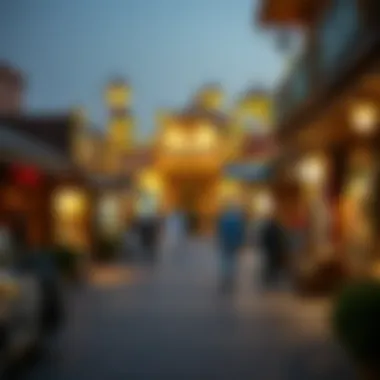
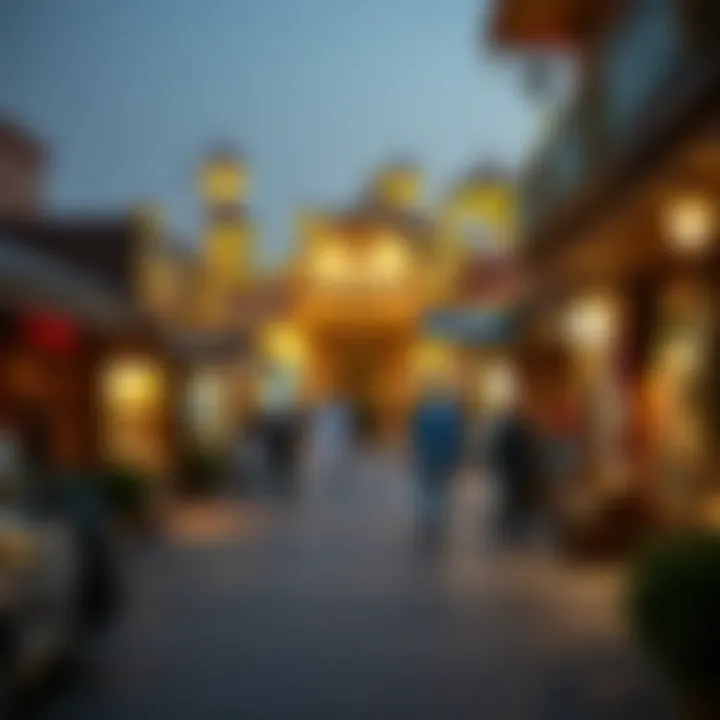
The Golden Souk serves as more than just a marketplace; it’s a pulsating heartbeat of tourism in Dubai. This lively bazaar attracts a diverse range of visitors from various backgrounds, drawn by the allure of its shimmering gold, intricate designs, and vibrant cultural essence. Understanding the dynamics bounding tourists' visits to the souk reveals not just consumer behavior, but also broader trends in travel and commerce within one of the world's most luxurious locales.
Visitor Demographics
The makeup of visitors to the Golden Souk is as varied as the merchandise sold there. Each year, millions flock to this iconic destination, spanning numerous age groups, nationalities, and purchasing power. Tourists from Asia, particularly India and Pakistan, play a significant role, with many arriving to celebrate personal milestones such as weddings or significant anniversaries.
In contrast, Western tourists, typically comprising families and adventure seekers, often blend cultural exploration with a desire to capture the essence of authentic Dubai. The landscape also features expats who frequent the souk for everyday shopping, showcasing the vibrant interaction between tourists and locals.
A brief overview of visitor demographics includes:
- Nationalities: Predominantly from India, Pakistan, Europe, Saudi Arabia, and the USA.
- Age Groups: Ranges from young adults eager for unique experiences to older visitors seeking prestige items.
- Purpose of Visit: Weddings, celebrations, cultural discovery, and everyday shopping.
Understanding these demographics helps tailor attractions and services to enhance the overall visitor experience.
Recommendations for Tourists
If embarking on a journey to the Golden Souk, there are several recommendations that can enhance one's experience:
- Timing Your Visit: Early mornings or late afternoons tend to be less crowded, allowing for a more leisurely exploration of the shops.
- Dress Appropriately: As a cultural hub, dressing modestly is advisable, respecting local customs.
- Engage in Bargaining: Negotiation is a key part of the shopping culture here. Don’t hesitate to haggle over prices; it’s part of the fun!
- Explore Beyond the Gold: While gold jewelry is the main draw, be sure to check out precious stones and traditional artifacts. These unique items showcase the craftsmanship and artistry of local artisans.
- Enjoy Cultural Delights: Take breaks to indulge in local snacks or beverages, available at nearby stalls. Savoring a cup of Arabic coffee or sampling some dates adds an authentic experience.
The Golden Souk isn’t just a shopping destination; it’s an experience steeped in culture and tradition. Plan your visit with these tips in mind, and you’ll leave with not only shimmering pieces of gold but also lasting memories of Dubai’s rich heritage.
"The Golden Souk stands as a living museum, inviting visitors to witness the craftsmanship and cultural richness of Dubai firsthand."
By understanding and navigating the tourism landscape effectively, potential investors, homebuyers, agents, analysts, and developers can glean valuable insights from the daily interactions and activities within this bustling marketplace. It's a treasure trove of information waiting to be uncovered.
Future Prospects
As the Golden Souk continues to thrive in the heart of Dubai, its future remains a topic of great interest. Investing in this unique marketplace not only promises financial returns but also contributes to preserving a key piece of cultural heritage. The dynamic nature of the Souk, coupled with the ever-evolving landscape of Dubai, makes its prospects exciting and substantial.
Sustainability Initiatives
Sustainability is on every responsible investor's lips now, and the Golden Souk is no exception. To align with global efforts towards sustainable development, the Souk is gradually adapting various initiatives.
- Waste Reduction Programs: Shops are encouraged to minimize waste generated from packaging and materials used in their products.
- Eco-Friendly Practices: Many vendors have begun to source materials from sustainable suppliers, which not only preserves the environment but also appeals to an increasingly eco-conscious customer base.
- Community Education: Programs that educate both merchants and visitors about the importance of sustainability play a crucial role in driving commitment towards environmentally sound practices within the Souk.
These steps not only enhance the Souk's reputation but also ensure it remains a relevant and attractive destination for future generations.
Modernization Efforts
While the Golden Souk holds onto its age-old charm, modernization plays a vital role in keeping it competitive in a rapidly changing world. The future will likely see a balance of tradition and innovation, appealing to both new and returning visitors.
Some modernization efforts currently in motion include:
- Technology Integration: Incorporating digital payment methods and online shopping platforms to enhance user experience.
- Aesthetic Enhancements: Brightening up spaces with modern yet culturally appropriate designs. This includes improved lighting and better navigation through the Souk, making it pedestrian-friendly.
- Global Partnerships: Working with international artisans and designers to introduce contemporary styles alongside traditional offerings, helping to bridge different markets.
These modernization strategies suggest a solid commitment to evolution while respecting the rich history embedded in the Golden Souk. They are expected to not only attract a wider audience but also elevate the overall experience, catering to the tastes and preferences of a new generation of shoppers.
Epilogue
The Golden Souk stands as more than just a traditional market; it is a cornerstone of Dubai’s identity and a reflection of its vibrant economy and culture. The souk intricately weaves together the past and the present, showcasing the timeless allure of gold and craftsmanship while adapting to the modern demands of a globalized world.
Understanding the significance of the Golden Souk involves recognizing its role in fostering local artisans and enhancing tourism. The experience within its bustling lanes is not merely about transactions; it’s about engaging with a heritage that has stood the test of time. Shoppers find themselves not only in pursuit of luxury items but also in an environment rich with stories and community connections.
Moreover, the economic implications of the souk extend into larger discussions about Dubai’s real estate market and its evolving landscape. Investors, homebuyers, and developers can glean insights from the dynamics in the souk, where tradition meets innovation. In this way, the souk is a microcosm of Dubai itself, presenting opportunities that are ripe for exploration.
In summary, the Golden Souk is a testament to Dubai’s past glories and future ambitions. Its importance is underscored by its ability to charm visitors and locals alike, bridging cultures and reinforcing the identity of a city that continually reshapes itself. From the gleaming gold displays to the vibrant haggling over prices, every aspect of the souk tells a story worth listening to—even for those just passing through.
"The true value of the Golden Souk lies not just in the gold traded but in the relationships forged in its vibrant heart."
As we look ahead, the Golden Souk will likely continue to adapt and thrive, serving as a beacon of culture and commerce in Dubai. This adaptability may well provide insights into future trends that may be observed in the broader marketplace. For those invested in understanding Dubai’s intricate tapestry, the Golden Souk is indeed the place to start.

